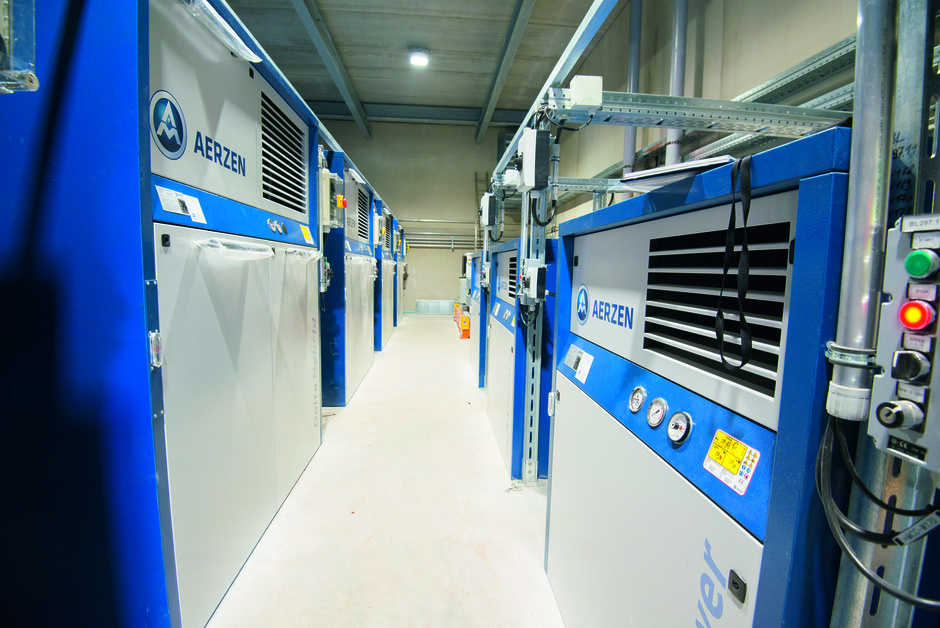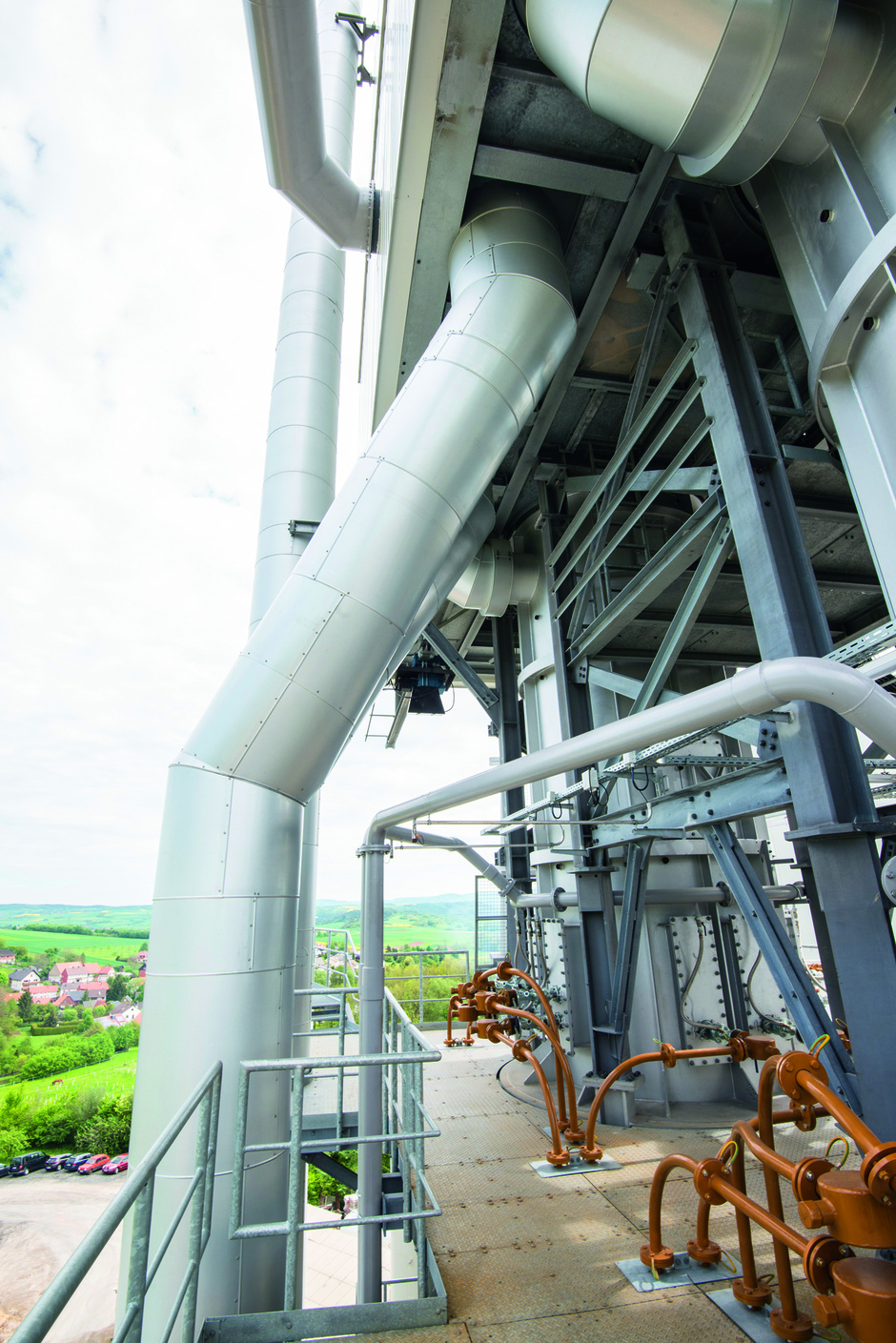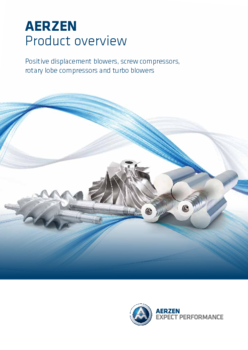Köhler Kalk GmbH: significant energy savings in the combustion air range thanks to the new AERZEN Load Balancing ControlIn line with the kiln furnace
The manufacture of lime and dolomite is extremely energy-intensive, with the burning process in particular causing high CO2 emissions. This is because extreme temperatures of between 900 and 1,200 degrees Celsius are required to convert the raw stone into quicklime. This means that intelligent solutions which make this process more sustainable are all the more important. The Northern Hesse family business Köhler Kalk has therefore been relying for many years on an ultra-modern direct current counter-current regenerative kiln furnace and energy efficient blower technology of AERZEN. With the implementation of Load Balancing Control (LBC),
Köhler Kalk has now gone a decisive step further: the intelligent control software operates the machine network, which supplies the kiln with the process air for the firing process (combustion air) at the optimum operating point at all times, thus enabling significant energy savings and process improvements. Köhler Kalk GmbH, based in the Werra-Meißner district (Northern Hesse), specialises in the extraction, processing and refinement of high-quality dolomitic lime, a crystalline mineral mixture of calcium and magnesium carbonate. One focus is the further processing of the raw dolomite stone in the kiln to produce burnt dolomite lime. This is particularly suitable for the steel industry because the magnesium content in the dolomite has a positive effect as an oxide (MgO) during steel production and protects the converter walls when refining the raw iron into steel. In general, the added lime has the task of binding the sulphur in the melt. Steel cookers are therefore regular customers of Köhler Kalk. In addition, the fertiliser and construction industries are also supplied on a large scale.
State-of-the-art firing technology in use
The central element in the production process of dolomite burnt lime at Köhler Kalk is the direct current counter-current regenerative kiln furnace. With an efficiency of over 80%, it is one of the most energy-efficient lime burners according to BAT (best available technology, part of the plant authorisation law according to EU Directive 2010/75/EU on industrial emissions). A direct current counter-current regenerative kiln furnace consists of two to three interconnected shafts, which are operated alternately as combustion and regeneration shafts in a cycle of around 15 minutes, and works according to the principle of regenerative heat recovery: the flue gas heat is saved and used to preheat the combustion air. This reduces both fuel consumption and emissions. Köhler Kalk was the first company in Germany to burn dolomite using the direct current counter-current regenerative kiln furnace process. The ultra-modern furnace was put into service at the Vockerode location (east of Kassel) in 2017.
AERZEN screw blowers: the best of both worlds
The combustion air is supplied by three AERZEN Screw blowers of the Delta Hybrid type - two D75L with belt drive (50 kW, 4,000 m³/h, 1,000 mbar) and one D65S with direct drive (90 kW, 3,900 m³/h, 1,250 mbar). The innovative packages combine the advantages of blower and compressor technology in one system and stand for maximal energy efficiency with very high reliability. Compared to conventional positive displacement blowers traditionally used in kilns, significant energy savings of up to 37% can be achieved. The supply air requirement for the firing process is not constant, but is subject to process and operational fluctuations. In addition to the production output, it is significantly influenced by the way the direct current
counter-current regenerative furnace works: the periodic switching of the air flow between the combustion and regenerative ducts leads to varying volume flow requirements. In addition, there are other influencing factors such as the quality of the fuel (e.g. calorific value or moisture content), differences in the composition of the dolomite raw brick, changing ambient conditions (outside temperature, air humidity) and the technical condition of
the kiln system (soiling or wear).
Load Balancing Control: intelligent control software
Load Balancing Control (LBC) enables these different requirements to be met in a particularly energy-efficient manner. The software was developed by Aerzen Digital Systems, the digitalisation specialist in the AERZEN Group, specifically for the automated operation of a machine network and opens up significant potential for the energetic optimisation of compressed air generation. LBC uses models validated in the test department to optimise the operating points of each machine in the network by means of test scenarios. This means that the overall efficiency of the network can be increased without having to resort to computationally complex real-time optimisation. At Köhler Kalk, the volume flow required for the current firing process is calculated by the master process control system of the direct current counter-current regenerative kiln furnace. The principal influencing variables (production output, operating mode, fuel quality, condition of the dolomite raw brick, outside temperature, air humidity, condition of the kiln) are all taken into account by measuring process variables such as the temperature of the fuel or exhaust gas. The direct current counter-current regenerative kiln furnace transmits the volume flow requirement to Load Balancing Control, which calculates the load distribution between the blowers and outputs corresponding control signals for the machines. The result is a machine network that operates at its optimum energy operating point and enables the operator to realise a Return on Investment in less than 2 years


how high the demand for process air in direct
current countercurrent regenerative kiln furnaces is.
Maximum efficiency with minimum integration effort
Load Balancing Control offers maximum flexibility and can be integrated into existing or newly created control environments with minimal effort. A customised function module is created for each customer, which is integrated directly into the system control and the existing SCADA is integrated. This saves time and costs. PLC systems from all common manufacturers are supported. The first step is always a detailed recording and evaluation of the existing plant technology and infrastructure - the same applies to Köhler Kalk. Reconciliation was also carried out with the system integrator of the dolomitic lime manufacturer. The PLC function block was then set up, taking all system-specific parameters into account. This contains all the functions of the LBC and is conveniently provided by Aerzen Digital Systems as a download. Thanks to model-based virtual commissioning, the function module has already been preset to such an extent that only fine-tuning is required on site at the customer’s premises. The system integrator implemented the function module in the control programming within a few hours by means of the documentation provided and seamlessly returned the system to productive operation.
Noise reduction as a positive side effect
The energy optimisation of compressed air generation is the central task of Load Balancing Control. But the software offers much more: it ensures that operating hours are balanced by evenly distributing the load on the machines, it avoids frequent load changes in the form of switch-on and switch-off processes and it allows individual packages to be specifically excluded from the control system. In addition, the project at Köhler Kalk had a positive
side effect in the form of a significant reduction in noise. The plant is located in the immediate vicinity of a village and there have been repeated complaints in the past due to high noise emissions. This required limiting the maximal speed of the machines, which meant that their full performance potential was not utilised. The use of Load Balancing Control made it possible to avoid interactions between the machines, which had previously led to an increase in overall noise emissions. This means that operation is now possible across the entire speed range, which also contributes to increased energy efficiency. This effect may be transferable to other systems.
Significant energy savings at Köhler Kalk
The LBC project at Köhler Kalk clearly indicates how digital intelligence, innovative blower technology and practical engineering merge into an economically and ecologically attractive solution. Thanks to AERZEN’s in-house technology and targeted machine-related expertise, the machine network for combustion air supply is always operated at its optimum. As a result, Köhler Kalk was able to realise sustainable energy savings of 6 to 10%. Christian Köhler, General Manager of Köhler Kalk GmbH, is delighted: “With the new Load Balancing Control, we have not only noticeably improved the energy efficiency of our combustion air supply, but have also significantly reduced noise emissions - without any supplemental hardware. We were particularly impressed by the simple integration into our existing system control.” Rising energy prices and ambitious climate targets at both global and national level are increasingly focussing attention on energy efficiency - and making greater climate protection one of the central goals of the energy-intensive lime industry. Screw blowers from AERZEN and the intelligent Load Balancing Control software are leading compressed air supply into the future.


